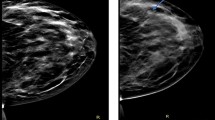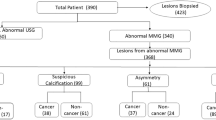Abstract
Objective
To compare the visibility of circumscribed masses on digital breast tomosynthesis (DBT) images and 2D mammograms and determine the usefulness of DBT for differentiation between benign and malignant circumscribed masses.
Methods
Seventy-one (19 malignant and 52 benign) mammographic well-circumscribed masses were included. Visibility of the masses and halo signs on DBT images were retrospectively compared with 2D mammograms. The effects of mammographic breast density on mass visibility were also evaluated.
Results
For DBT, 83% were superior and 17% were equivalent in visibility of the masses to that of 2D, and superiority of DBT was significantly enhanced in the high breast density group compared with the low breast density group (91% vs 68%, respectively, p = 0.016). Three lesions were only detected on DBT. There was no significant difference in the superiority of DBT for lesion visibility between malignant and benign masses. The halo sign was detected in 58% lesions on DBT and in 4% on 2D (p < 0.001).
Conclusion
Circumscribed masses were better visualized on DBT than on 2D mammograms, particularly in high-density breasts. The halo sign often appeared on DBT and gave a clearer mass margin. However, circumscribed masses on DBT are not assured of being benign.
Key Points
• Circumscribed masses were better visualized on breast tomosynthesis than on 2D mammography.
• Tomosynthesis visualized circumscribed masses better than 2D for all breast density categories.
• Halo signs often appeared on tomosynthesis and contributed to detect circumscribed margins.
• Circumscribed masses on tomosynthesis images are not assured of being benign lesions.




Similar content being viewed by others
References
Uematsu T (2013) The emerging role of breast tomosynthesis. Breast Cancer 20:204–212
Skaane P, Bandos AI, Gullien R et al (2013) Comparison of digital mammography alone and digital mammography plus tomosynthesis in a population-based screening program. Radiology 267:47–56
Ciatto S, Houssami N, Bernardi D et al (2013) Integration of 3D digital mammography with tomosynthesis for population breast-cancer screening (STORM): a prospective comparison study. Lancet Oncol 14:583–589
Haas BM, Kalra V, Geisel J, Raghu M, Durand M, Philpotts LE (2013) Comparison of tomosynthesis plus digital mammography and digital mammography alone for breast cancer screening. Radiology 269:694–700
Friedewald SM, Rafferty EA, Rose SL et al (2014) Breast cancer screening using tomosynthesis in combination with digital mammography. JAMA 311:2499–2507
Rafferty EA (2007) Digital mammography: novel applications. Radiol Clin N Am 45(831-843):vii
Andersson I, Ikeda DM, Zackrisson S et al (2008) Breast tomosynthesis and digital mammography: a comparison of breast cancer visibility and BIRADS classification in a population of cancers with subtle mammographic findings. Eur Radiol 18:2817–2825
Good WF, Abrams GS, Catullo VJ et al (2008) Digital breast tomosynthesis: a pilot observer study. AJR Am J Roentgenol 190:865–869
Teertstra HJ, Loo CE, van den Bosch MA et al (2010) Breast tomosynthesis in clinical practice: initial results. Eur Radiol 20:16–24
Sickles EA (1994) Nonpalpable, circumscribed, noncalcified solid breast masses: likelihood of malignancy based on lesion size and age of patient. Radiology 192:439–442
Uematsu T, Kasami M (2009) MR imaging findings of benign and malignant circumscribed breast masses: part 1. Solid circumscribed masses. Jpn J Radiol 27:395–404
Uematsu T, Kasami M (2009) MR imaging findings of benign and malignant circumscribed breast masses: part 2. Cystic circumscribed masses. Jpn J Radiol 27:405–409
Yoo JL, Woo OH, Kim YK et al (2010) Can MR Imaging contribute in characterizing well-circumscribed breast carcinomas? Radiographics 30:1689–1702
Wang Y, Ikeda DM, Narasimhan B et al (2008) Estrogen receptor-negative invasive breast cancer: imaging features of tumors with and without human epidermal growth factor receptor type 2 overexpression. Radiology 246:367–375
Schrading S, Kuhl CK (2008) Mammographic, US, and MR imaging phenotypes of familial breast cancer. Radiology 246:58–70
Kaas R, Kroger R, Hendriks JH et al (2004) The significance of circumscribed malignant mammographic masses in the surveillance of BRCA 1/2 gene mutation carriers. Eur Radiol 14:1647–1653
Tilanus-Linthorst M, Verhoog L, Obdeijn IM et al (2002) A BRCA1/2 mutation, high breast density and prominent pushing margins of a tumor independently contribute to a frequent false-negative mammography. Int J Cancer 102:91–95
American College of Radiology (2013) ACR BI-RADS Atlas: Breast Imaging Reporting and Data System. 5th ed
Cupples TE, Eklund GW, Cardenosa G (1996) Mammographic halo sign revisited. Radiology 199:105–108
Gilbert FJ, Tucker L, Gillan MG et al (2015) Accuracy of digital breast tomosynthesis for depicting breast cancer subgroups in a UK retrospective reading study (TOMMY Trial). Radiology. doi:10.1148/radiol.2015142566:142566
Leung JW, Sickles EA (2000) Multiple bilateral masses detected on screening mammography: assessment of need for recall imaging. AJR Am J Roentgenol 175:23–29
Michell MJ, Iqbal A, Wasan RK et al (2012) A comparison of the accuracy of film-screen mammography, full-field digital mammography, and digital breast tomosynthesis. Clin Radiol 67:976–981
Moskowitz M (1983) Minimal breast cancer redux. Radiol Clin N Am 21:93–113
Swann CA, Kopans DB, Koerner FC, McCarthy KA, White G, Hall DA (1987) The halo sign and malignant breast lesions. AJR Am J Roentgenol 149:1145–1147
Gordenne WH, Malchair FL (1988) Mach bands in mammography. Radiology 169:55–58
Sechopoulos I (2013) A review of breast tomosynthesis. Part II. Image reconstruction, processing and analysis, and advanced applications. Med Phys 40:014302
Acknowledgments
The scientific guarantor of this publication is Takayoshi Uematsu. The authors of this manuscript declare no relationships with any companies, whose products or services may be related to the subject matter of the article.The authors state that this work has not received any funding.
No complex statistical methods were necessary for this paper. Institutional Review Board approval was obtained. Written informed consent was waived by the Institutional Review Board. Methodology: retrospective, case-control study, performed at one institution.
Author information
Authors and Affiliations
Corresponding author
Rights and permissions
About this article
Cite this article
Nakashima, K., Uematsu, T., Itoh, T. et al. Comparison of visibility of circumscribed masses on Digital Breast Tomosynthesis (DBT) and 2D mammography: are circumscribed masses better visualized and assured of being benign on DBT?. Eur Radiol 27, 570–577 (2017). https://doi.org/10.1007/s00330-016-4420-5
Received:
Revised:
Accepted:
Published:
Issue Date:
DOI: https://doi.org/10.1007/s00330-016-4420-5




